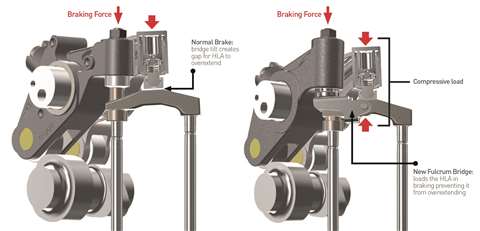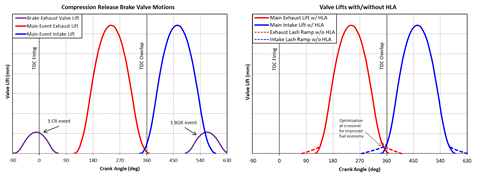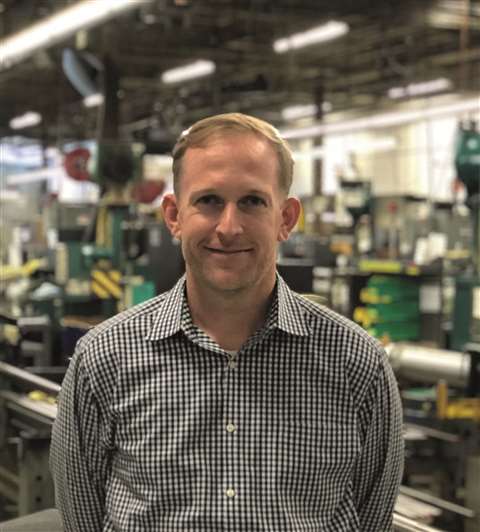Jacobs bridge systems yield non-road engine brake opportunities
06 June 2022
 A representation of how engine brakes used on engines with hydraulic lash adjusters (HLA) can overextend during braking (left) and how Jacobs Vehicle Systems’ patented Fulcrum Bridge technology (right) eliminates that problem. (Photo: Jacob Vehicle Systems)
A representation of how engine brakes used on engines with hydraulic lash adjusters (HLA) can overextend during braking (left) and how Jacobs Vehicle Systems’ patented Fulcrum Bridge technology (right) eliminates that problem. (Photo: Jacob Vehicle Systems)
For most of its 61-year history, the majority of Jacobs Vehicle Systems engine retarding and valve actuation products have been used on heavy-duty trucks. Indeed, the company’s engine compression brakes, the iconic “Jake Brake,” have been applied to nearly 10 million commercial vehicles around the world.
Yet when the Bloomfield, Conn., company went into production with its new Fulcrum Bridge technology in the latter half of 2021, it was with an eye toward expanding engine brake systems for off-highway equipment applications.
“Using engine brakes in large off-road machines isn’t really that new,” said Gabriel Roberts, director of product development at Jacobs. “A few manufacturers, such as Case New Holland, have been putting engine brakes in their large tractors for a long time. And Caterpillar has been using engine brakes off-highway forever.
“Off-highway engine braking has been around for a while, but now it seems like more OEMs are catching up and they want to offer the same functionalities on their machines.”
What’s helped spur that interest is the development of Jacobs’ patented Fulcrum Bridge and Spring Bridge technologies, which essentially make engine brakes applicable to a broader range of heavy-duty off-highway engines.
How they work
Engine brakes operate on the exhaust side of an engine’s valvetrain, actuating a specially designed brake rocker atop the exhaust valve that opens the valve at top dead center of the compression stroke, thus releasing the energy of compression into the exhaust stream. This delivers a braking effect from the engine, which helps slow the machine and reduces wear on the service brakes.
Most medium- and heavy-duty engines incorporate hydraulic lash adjusters (HLAs), which are designed to set and maintain the clearance in the valvetrain between the valve and camshaft for the life of the engine with no adjustment required. However, the presence of HLAs generally precluded the use of engine brakes, as the tilting of the valve bridge during braking could cause the HLA to overextend, potentially causing the exhaust valve and piston to come in contact, resulting in significant engine damage.
 Typical Valve Lifts (shown exaggerated for illustrative purposes) of engine brakes with and without hydraulic lash adjusters (HLA). (Photo: Jacob Vehicle Systems)
Typical Valve Lifts (shown exaggerated for illustrative purposes) of engine brakes with and without hydraulic lash adjusters (HLA). (Photo: Jacob Vehicle Systems)
Jacobs’ Fulcrum Bridge technology incorporates a slightly off-centered contact point between the braking valve to the valve bridge and a specially designed linkage that enables the brake valve tip to act as a fulcrum point, imparting an upward force through the bridge to keep the HLA in its optimal operating position and prevent any contact between components.
One compromise in the design of the Fulcrum Bridge is that the position where the engine brake actuates the braking valve changes to have the fulcrum effect on the HLA. The same valvetrain cannot be used in HLA and non-HLA equipped engines, which led to the development of the Spring Bridge.
While the operating mechanism of the Spring Bridge is different, the fundamental objective is the same – to keep the HLA loaded during engine braking to prevent overextension of the HLA leading to engine damage. The Fulcrum Bridge may not be used on all engine designs because of the valve pattern, injector location or other space constraint. The Spring Bridge is designed to accommodate such variations, with the ability to incorporate the same mechanism into other valvetrain elements such as the rocker arm, push tube, finger-follower or cam follower.
Expanded applications
The Fulcrum Bridge or Spring Bridge technologies are compatible with most engine brake designs, the company said, including dedicated cam rocker brakes, overhead bolt-on brakes, bleeder brakes and lost motion rocker brakes. Thus, the system is suitable for most off-highway engines in the market and most recently, a manufacturer of agricultural equipment has adopted the first production brakes with the Fulcrum Bridge system into its machines.
“For that customer, the initial ratings are in the 300 to 350 kW (400 to 469 hp) of negative (braking) power, which is good,” said Roberts. “The engine brake is capable of more, but the OEM had kind of a mellow approach at launch. We’ve validated it to over 400 kW (536 hp), but the plan is to start lower and turn it up later on.”
 “The big benefit of the engine brake is safety. You’re slowing the vehicle down and you don’t have the fade of foundation brakes.” - Gabriel Roberts, Jacobs Vehicle Systems
“The big benefit of the engine brake is safety. You’re slowing the vehicle down and you don’t have the fade of foundation brakes.” - Gabriel Roberts, Jacobs Vehicle Systems
Over time, Jacobs expects its engine brakes with Fulcrum Bridge technology to migrate to other applications, such as articulated dump trucks used in construction and mining, as well as vocational vehicles.
“The big benefit of the engine brake is safety,” Roberts said. “You’re slowing the vehicle down and you don’t have the fade of foundation brakes. With the engine brake, you can use it forever and it doesn’t fade.
“I had an experience once in the Alps. There are farms all over the hills and I was just wondering how a farmer could drive a tractor on those hills. It was explained to me that in the Alps – and in some places in Idaho that have significant mountain terrain and they’re driving the tractors up and down massive inclines – they have to be able to slow the vehicle down for safety.
“A second experience was with a customer that was hauling two scraper implements. When he’d drop those scrapers down and they’d start scooping dirt, it went from an unloaded tractor to 75 tons in a matter of seconds. He demonstrated how he has to be able to stop with that amount of weight and sometimes that’s difficult to do, especially if there are any declines.
“The amount of weight that you can be hauling on some of the equipment is overwhelming and the engine brake can basically double the amount of stopping power, so it provides more safety and more confidence to the driver.”
Longer brake life
Other benefits engine brakes bring to off-highway applications include reduced maintenance – there is no need to adjust valve lash during scheduled maintenance – reduced engine noise, vibration and Harshness (NVH) and extended service brake life. “With an engine brake, your foundation brakes last two to five times as long,” Roberts said. “So, your total cost of ownership is less.”
Since the Fulcrum Bridge system went into production, Roberts said it’s drawn the interest of other off-highway equipment manufacturers. “There are other OEMs around the world that use HLAs in their off-highway valvetrains,” he said. “Before, they’ve had to make a decision between the engine brake and the HLA. With the development of this technology, it’s opened up a lot of business in off-highway.”
Fulcrum Bridge technology can also provide benefits in on-highway applications, which are facing new, more stringent emissions regulations starting in 2024. Engines with HLAs allow the factory valve lift settings to be maintained throughout the life of the engine, maintaining original engine combustion and emissions performance and also keeping DPF regen intervals consistent, the company said.
Jacobs manufactures its engine brakes with Fulcrum Bridge at its Bloomfield headquarters facility on an advanced semi-automated manufacturing line. “Some characteristics around the Fulcrum Bridge require precision machining and capability,” Roberts said. “So, we use automation to make sure things are manufactured, machined, assembled and tested the right way before they go out.”
STAY CONNECTED




Receive the information you need when you need it through our world-leading magazines, newsletters and daily briefings.
POWER SOURCING GUIDE
The trusted reference and buyer’s guide for 83 years
The original “desktop search engine,” guiding nearly 10,000 users in more than 90 countries it is the primary reference for specifications and details on all the components that go into engine systems.
Visit Now
CONNECT WITH THE TEAM









